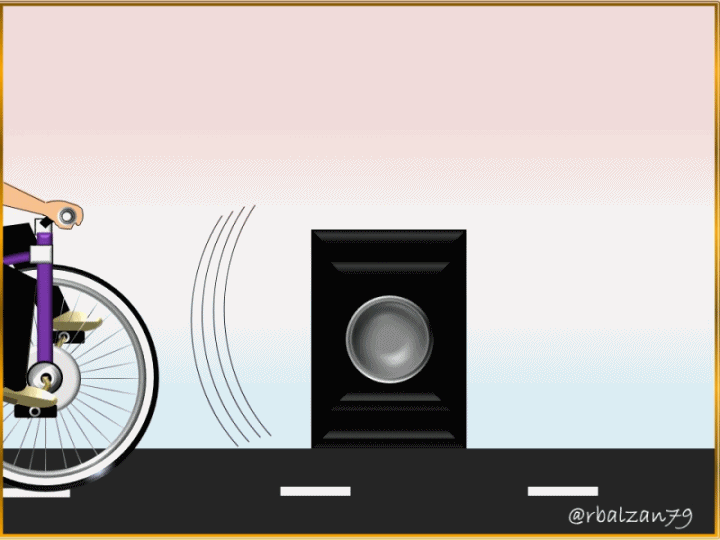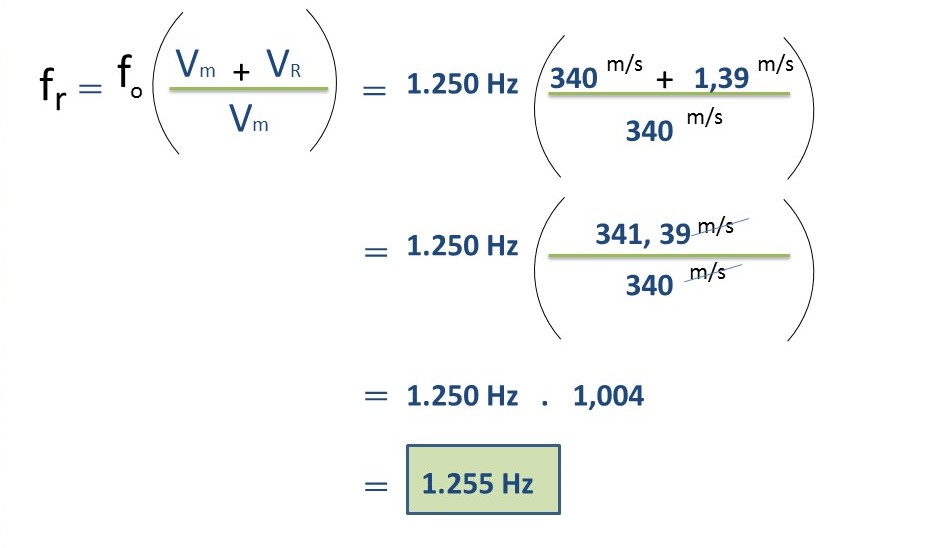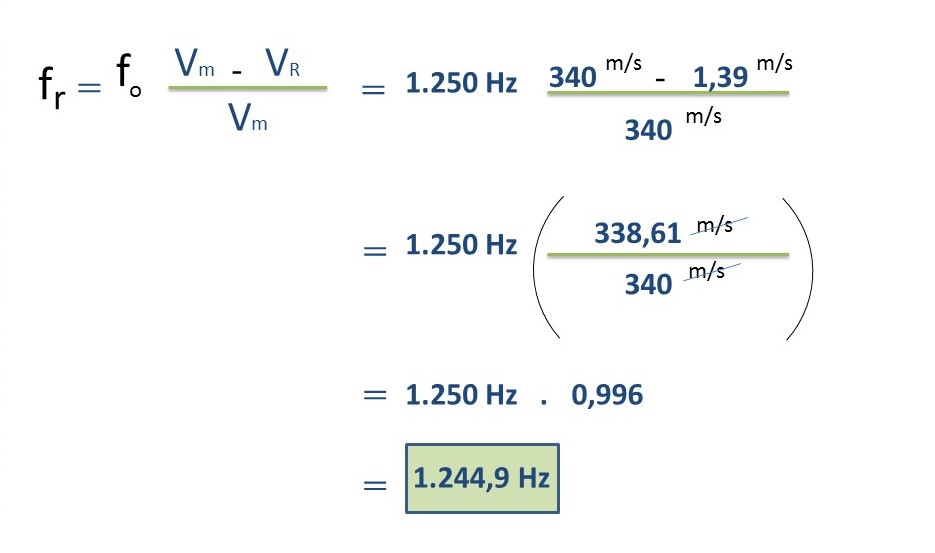
Dentro del sonido existen otros fenómenos, uno de ellos, ya lo comenzamos a analizar en anteriores publicaciones como el efecto Doppler, pero, en aquella ocasión lo hicimos con la condición donde el receptor del sonido estaba inmóvil, ahora lo haremos cuando dicho receptor es el que se encuentra en movimiento y, la fuente de emisión del sonido inmóvil, es decir, invirtiendo las condiciones de movilidad, y para ello, utilizaremos de igual forma la formulación general del efecto Doppler y, la adaptaremos a las condiciones antes descritas.
Por aquí les comparto la publicación anterior del efecto Doppler.
Por lo tanto, pasemos a describir el siguiente ejercicio práctico.
Ejercicio
Una persona que se desplaza montada en una antigua bicicleta se aproxima a un foco o fuente de emisión de sonido, esta persona transita con una velocidad de 5 km/h, lógicamente el sonido que perciben sus oídos se propagan por el aire, y cuya velocidad de propagación por este medio es de 340 m/s, y la frecuencia de emisión de estas ondas sonoras es de 1.250 Hz, por lo tanto, en relación a todo lo antes expuesto, responder a las siguientes interrogantes:
a.- ¿Cómo podemos analizar la formulación general de este fenómeno (Efecto Doppler), cuando el receptor del sonido es el que se moviliza?
b.- ¿Cuáles serán las frecuencias percibidas por el receptor que se moviliza hacia el foco de emisión del sonido, bien sea acercándose como alejándose de dicha fuente de emisora?
Solución
a.-En una anterior entrega nos relacionamos con este fenómeno del efecto Doppler, en aquella ocasión el receptor del sonido permaneció inmóvil, mientras la fuente de emisión del sonido era la que se movilizaba o estaba en movimiento, ahora vamos a invertir estas condiciones, es decir, el receptor será el que se moviliza, para ello, comenzaremos analizando la formulación general para este fenómeno, y adaptarla a las condiciones dada para este ejercicio.

fr = Es la frecuencia del sonido percibida por el receptor.
fo = Representa la frecuencia del sonido del foco emisor.
Vm = Velocidad del medio de propagación del sonido (El aire en este caso)
VR = Velocidad del receptor.
Vf = Velocidad del foco emisor del sonido.
Es importante señalar que, si el foco emisor del sonido se encuentra inmóvil, su velocidad será nula, y de esta manera podemos pasar a responder la segunda interrogante, por lo que la fórmula 1 se reduce a lo siguiente:

Con esta fórmula 2, podemos dar respuesta al planteamiento realizado, debido a que la hemos adaptado a las condiciones descritas en el ejercicio (receptor en movimiento y foco emisor inmóvil), por lo tanto, seguimos con el desarrollo.
b.- Datos:
fo = 1250 Hz.
Vm = 340 m/s.
VR = 5 km/h * 1 h/3600 s * 1000 m/km = 1,39 m/s.
Antes de aplicar la fórmula 2, es importante señalar que utilizaremos el signo más (+) cuando el receptor del sonido se acerca a la fuente emisora de estas ondas sonoras, y el signo menos (-) cuando se aleja, por lo tanto, podemos continuar con la siguiente fórmula para el signo más (+).


Esta es la frecuencia del sonido percibido por el receptor cuando se acerca a la fuente de emisión del sonido.
Ahora veamos que sucede cuando el receptor comienza a distanciarse de dicha fuente de emisión de sonido, para ello, presentamos la siguiente formulación para el signo menos (-):


Esta es la frecuencia del sonido percibido por el receptor cuando se aleja del foco emisor de las ondas sonoras.
Análisis de los resultados
Seguimos comprobando que el fenómeno que hace que un receptor perciba distinta frecuencia a la emitida por un foco emisor de sonido, es el efecto Doppler, para este ejemplo en particular, la frecuencia emitida por la fuente de emisión de sonido era de 1.250 Hz, y las frecuencias calculadas percibidas por el receptor fueron de 1.255 Hz al momento de acercarse a la fuente de emisión de sonido, y de 1.244,9 Hz al momento de alejarse, tomando las condiciones dadas, es decir, el receptor en movimiento y, la fuente de emisión del sonido inmóvil o en reposo, notando con ello, las siguientes relaciones frecuenciales del sonido.

Hasta otra oportunidad mis queridos amigos.
Nota: Las imágenes fueron realizadas por el autor utilizando Power Point y Paint, el gif animado fue estructurado con la aplicación de PhotoScape.
Referencias Bibliográficas recomendadas
[1] MOVIMIENTO ONDULATORIO. Link.
[2] Doppler Effect. Link.


Within the sound there are other phenomena, one of them, we have already started to analyze in previous publications as the Doppler effect, but on that occasion we did it with the condition where the sound receiver was motionless, now we will do it when the receiver is the one in motion and the source of sound emission motionless, that is, reversing the conditions of mobility, and for this, we will use the general formulation of the Doppler effect and adapt it to the conditions described above.
Here I share with you the previous publication of the Doppler effect.
Therefore, let us now describe the following practical exercise.
Exercise
A person riding an old bicycle approaches a source or source of sound emission, this person travels with a speed of 5 km/h, logically the sound that his ears perceive is propagated through the air, and whose speed of propagation through this medium is 340 m/s, and the frequency of emission of these sound waves is 1,250 Hz, therefore, in relation to all the above, answer the following questions:
a.- How can we analyze the general formulation of this phenomenon (Doppler Effect), when the receiver of the sound is the one being mobilized?
b.- What will be the frequencies perceived by the receiver moving towards the source of the sound emission, either approaching or moving away from the emitting source?
Solution
a.-In a previous installment we related to this phenomenon of the Doppler effect, in that occasion the sound receiver remained motionless, while the sound emission source was the one that moved or was in motion, now we will reverse these conditions, i.e., the receiver will be the one that moves, for this, we will begin by analyzing the general formulation for this phenomenon, and adapt it to the conditions given for this exercise.

fr = It is the frequency of the sound perceived by the receiver.
fo = Represents the sound frequency of the emitting source.
Vm = Velocity of the sound propagation medium (air in this case)
VR = Receiver speed.
Vf = Speed of the sound emitting source.
It is important to note that, if the sound emitting focus is immobile, its velocity will be zero, and thus we can go on to answer the second question, so formula 1 is reduced to the following:

With this formula 2, we can give an answer to the approach made, since we have adapted it to the conditions described in the exercise (receiver in motion and emitter focus immobile), therefore, we continue with the development.
b.- Data:
fo = 1250 Hz.
Vm = 340 m/s.
VR = 5 km/h * 1 h/3600 s * 1000 m/km = 1,39 m/s.
Before applying formula 2, it is important to note that we will use the plus sign (+) when the receiver of the sound approaches the source emitting these sound waves, and the minus sign (-) when it moves away, therefore, we can proceed with the following formula for the plus sign (+).


This is the frequency of the sound perceived by the receiver when it approaches the source of the sound emission.
Now let's see what happens when the receiver starts to distance itself from the source of the sound emission, for this, we present the following formulation for the minus sign (-):


This is the frequency of the sound perceived by the receiver when it moves away from the source of the sound waves.
Analysis of results
We continue to verify that the phenomenon that makes a receiver perceive different frequency to that emitted by a sound emitting source, is the Doppler effect, for this particular example, the frequency emitted by the sound emitting source was 1,250 Hz, and the calculated frequencies perceived by the receiver were 1. 255 Hz at the moment of approaching the sound emission source, and of 1,244.9 Hz at the moment of moving away, taking the given conditions, that is to say, the receiver in movement and, the sound emission source motionless or at rest, noticing with it, the following frequency relations of the sound.

Until another opportunity my dear friends.
Note: The images were created by the author using Power Point and Paint, the animated gif was structured with the PhotoScape application.
Recommended Bibliographic References
[1] MOVIMIENTO ONDULATORIO. Link.
[2] Doppler Effect. Link.
Su post ha sido valorado por @ramonycajal
Gracias por el valioso apoyo a toda la comunidad de @Cervantes. Saludos.
Nice class about calculating sound waves
!1UP
Thanks for commenting and for the support. Best regards.
You have received a 1UP from @gwajnberg!
@stem-curator, @neoxag-curator
And they will bring !PIZZA 🍕.
Learn more about our delegation service to earn daily rewards. Join the Cartel on Discord.
Thanks for your contribution to the STEMsocial community. Feel free to join us on discord to get to know the rest of us!
Please consider delegating to the @stemsocial account (85% of the curation rewards are returned).
You may also include @stemsocial as a beneficiary of the rewards of this post to get a stronger support.
Thank you dear community for your valuable support. Best regards.